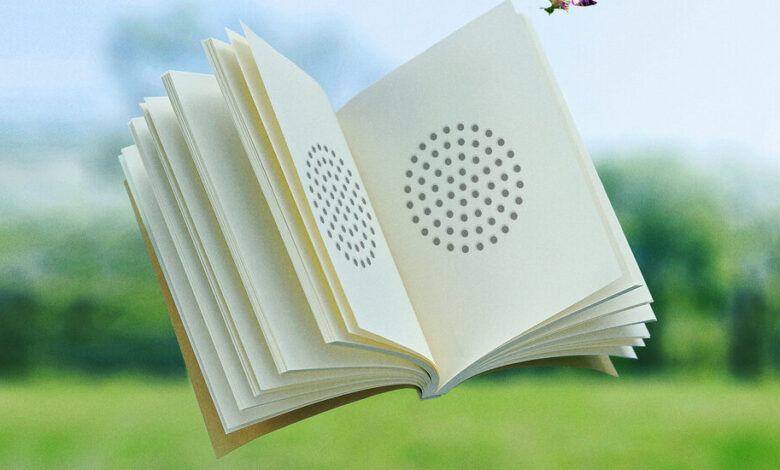The Benefits of Reading Out Loud

A few years ago, my youngest sister, Heather, had a monthlong stretch of migraines. She usually managed to get through her day as a teacher, but at night, she would retreat to a dark room so the light wouldn’t worsen her headache. To distract her from the anxiety and pain, I offered to read aloud to her on speakerphone while she closed her eyes.
Every evening until her migraines finally receded, I’d pick something — a short story from Jane Gardam, an essay from Samantha Irby. Heather said my voice was soothing, and reminded her of our childhood, when I read her stories (and our five-year age difference seemed a lot wider).
I found that I looked forward to adult story time as much as Heather did.
When we think of reading aloud, we often associate it with kids, said Kate DiCamillo, the author of “Because of Winn-Dixie,” which won the Newbery Medal for children’s books, and the upcoming “Ferris.” But grown-ups need to hear stories spoken out loud, too, she said.
At book events, DiCamillo urges audiences to read to other adults. “It is an act of love to read to somebody,” DiCamillo told me. “You feel cocooned, almost. It’s kind of like everybody puts down their defenses and you’re together in the story.”
Many of us learned to enjoy being read to as children, “under the crook of an arm, where ideal reading begins,” said Maryanne Wolf, a researcher and scholar at U.C.L.A.’s School of Education and Information Studies, and the author of “Reader, Come Home: The Reading Brain in a Digital World.”
In adulthood, “we may not put each other under a physical crook of an arm, but we put each other under an emotional crook of the arm,” Dr. Wolf said.
And research suggests the act of reading aloud may benefit the reader, too: It may improve memory, cognitive function, focus and mood.
But sometimes adults have fallen out of practice, Dr. Wolf said. Here’s how to ease into it.
Start with something short.
Pick a person that you are comfortable around, DiCamillo suggested, and begin with a brief passage like an essay or a poem. (She recommended any volume from the anthology “Poem a Day: A Wide Range of Classic and Modern Poems.”)
If you’re ready to try short stories, “Binocular Vision,” a collection by Edith Pearlman, “is spectacular to read out loud,” DiCamillo said. She also recommended “Peace Like a River,” a chapter book by Leif Enger.
Find any opportunity to read.
You can read a passage to your partner before bed, DiCamillo said, or to your family during breakfast. “So every morning, the book’s right there on the kitchen table. Everybody’s in the kitchen, and you just read a chapter,” she said.
Bring along a book when you’re visiting someone in the hospital or at a nursing home, she said. If that person is in pain or having difficulty concentrating, she added, try children’s literature.
Focus on your connection rather than getting every word right.
Typically, Dr. Wolf said, we think about reading “as this cognitive and linguistic activity.” But it also activates empathic areas in our brain “that trigger our ability to go beyond ourselves and to reach into the thoughts and feelings of others,” she said. In the act of reading, she added, “we are transmitting emotions, we are transmitting affection.”
And while reading aloud can make some of us feel self-conscious, DiCamillo said to remind yourself that this is not a test, so don’t worry about nailing every word.
Reading aloud, she said, is a profound way to connect with somebody. “You’re offering yourself,” she said. “It doesn’t have to be perfect.”
Need more inspiration? I asked two novelists for their favorite selections to read aloud.
Maurice Carlos Ruffin, author of the upcoming “The American Daughters,” chose Deesha Philyaw’s short story “Peach Cobbler,” which appears in her collection “The Secret Lives of Church Ladies.”
“Philyaw is our reigning modern master of the short story,” Ruffin said.
Celeste Ng, the author of “Our Missing Hearts,” recommended “Howl’s Moving Castle” by Diana Wynne Jones.
“When I learned my husband had never even heard of one of my favorite books from childhood, I dug up my old copy,” Ng said. “For a week, we took turns reading it to each other, and I’m happy to say it holds up beautifully.”
Revisit your stance on red wine.
Three decades ago, research suggested that a glass or two of red wine might benefit the heart. Since then, many more studies have confirmed that red wine does not protect against heart disease.
Read the article: How Red Wine Lost Its Health Halo
Remember the Presidential Physical Fitness Test? Here’s how it holds up.
If you went to an American public school between 1966 and 2012, you may have memories of a mile run, sit-ups, pull-ups or push-ups, a sit-and-reach and a shuttle run. The test is still usable, experts say, with some modifications.
Read the article: Could You Pass the Presidential Physical Fitness Test Today?
The Week in Well
Here are some stories you don’t want to miss:
Let’s keep the conversation going. Follow Well on Instagram, or write to us at well_newsletter@nytimes.com. And check out last week’s newsletter about how to apologize like you mean it.
Source link



